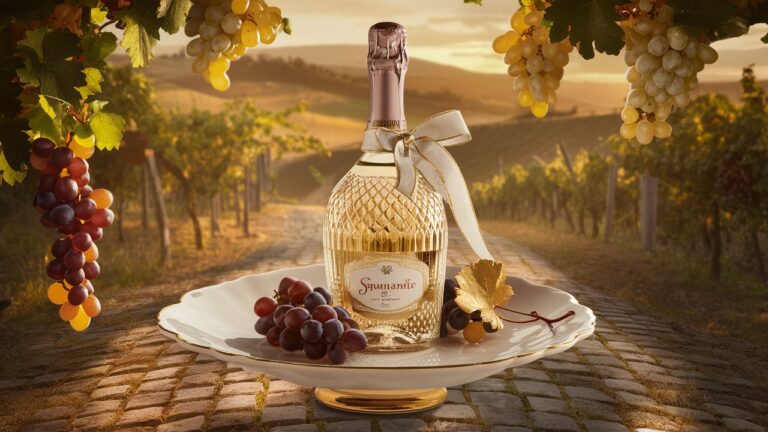Introduction to Spumante: Italy’s Effervescent Treasure
Spumante, the Italian word for “sparkling,” is more than just a category of wine—it’s a celebration in a glass. Originating from Italy’s lush vineyards, Spumante has captivated palates worldwide with its vibrant bubbles, aromatic complexity, and versatility. Unlike its French counterpart, Champagne, Spumante is crafted using a variety of grape blends and production methods, resulting in a spectrum of styles from sweet to bone-dry. This article delves into the history, production techniques, popular varieties, and cultural significance of Spumante, while answering common questions about this effervescent delight. Whether you’re a seasoned connoisseur or a curious novice, prepare to uncork the secrets of Italy’s most iconic sparkling wine.
The History and Origins of Spumante
The roots of Spumante trace back to ancient Rome, where early winemakers experimented with fermentation techniques to create bubbly wines. However, the modern iteration of Spumante began in the 19th century, inspired by the success of Champagne. Northern Italy, particularly the regions of Piedmont, Veneto, and Lombardy, became the epicenter of Spumante production. The unique terroir—characterized by alpine climates, mineral-rich soils, and sunny slopes—provided ideal conditions for growing grapes like Glera (used in Prosecco), Moscato Bianco, and Chardonnay. Over time, Spumante evolved into a symbol of Italian craftsmanship, celebrated at weddings, festivals, and everyday gatherings. Its accessibility and affordability compared to Champagne further cemented its global popularity.
The Art of Crafting Spumante: Traditional vs. Charmat Method
Spumante’s signature effervescence is achieved through meticulous production methods. The Traditional Method (Metodo Classico), akin to Champagne’s process, involves a secondary fermentation in the bottle. This labor-intensive technique creates fine, persistent bubbles and complex flavors, often seen in premium Spumantes like Franciacorta. In contrast, the Charmat Method (Tank Method) is faster and more economical. Here, the secondary fermentation occurs in large stainless-steel tanks, preserving the wine’s fresh, fruity notes—a hallmark of Prosecco. The choice of method depends on the desired style: Metodo Classico yields structured, age-worthy wines, while the Charmat Method emphasizes vibrancy and accessibility.
Popular Types of Spumante: From Prosecco to Asti
Spumante encompasses a diverse range of styles, each with distinct characteristics:
- Prosecco: Italy’s most famous Spumante, made from Glera grapes in Veneto. Known for its floral aromas, crisp apple flavors, and approachable sweetness.
- Asti Spumante: A sweet, aromatic wine from Piedmont, crafted from Moscato Bianco. Its low alcohol content and peach-forward profile make it a dessert favorite.
- Franciacorta: Often dubbed “Italy’s Champagne,” this Metodo Classico Spumante from Lombardy uses Chardonnay and Pinot Noir, offering toasty, creamy textures.
- Trento DOC: Hailing from Trentino, this refined Spumante blends traditional grapes with alpine freshness, ideal for pairing with seafood.
Pairing Spumante with Food: A Culinary Adventure
The versatility of Spumante makes it a stellar companion for a wide array of dishes. Dry varieties like Brut Spumante elevate salty appetizers like prosciutto, olives, and Parmesan. Off-dry styles such as Extra Dry Prosecco balance spicy Asian cuisine or creamy risottos. For desserts, the sweetness of Asti Spumante harmonizes with fruit tarts, panettone, or dark chocolate. Even savory mains like grilled shrimp or lemon-roasted chicken benefit from Spumante’s acidity and effervescence, which cleanse the palate between bites.

Serving and Storing Spumante: Tips for Optimal Enjoyment
To fully appreciate Spumante’s nuances, serve it chilled (6–8°C for sweeter styles, 8–10°C for drier ones) in tulip-shaped flutes that concentrate aromas. Avoid freezing the wine, as extreme cold mutes its flavors. Once opened, reseal the bottle with a sparkling wine stopper and refrigerate; most Spumantes retain their bubbles for 1–3 days. For long-term storage, keep unopened bottles in a cool, dark place, ideally horizontally. While Prosecco and Asti are best enjoyed young, premium Metodo Classico Spumantes can age gracefully for 5–10 years.
Conclusion: Spumante as a Symbol of La Dolce Vita
Spumante embodies the Italian ethos of joy, craftsmanship, and shared moments. Its effervescence transcends occasions, turning ordinary dinners into celebrations and fostering connections among friends and family. As global demand grows, Spumante continues to innovate while honoring its heritage, ensuring its place as a timeless icon of sparkling wine. Whether sipped poolside or toasted at a gala, Spumante invites everyone to embrace life’s bubbles.
Frequently Asked Questions About Spumante
Q: Is Spumante always sweet?
A: No. Spumante ranges from bone-dry (Brut Nature) to sweet (Dolce). Prosecco is typically off-dry, while Asti is sweeter.
Q: How does Spumante differ from Champagne?
A: Spumante is Italian and uses different grapes/methods. Champagne is French, uses Chardonnay/Pinot Noir, and has stricter production rules.
Q: Can Spumante age well?
A: Most are best consumed young, but high-quality Metodo Classico Spumantes (e.g., Franciacorta) can develop complexity over 5+ years.
Q: Is Spumante vegan-friendly?
A: Many are, but some producers use animal-derived fining agents. Check labels for vegan certifications.
Q: What’s the price range for Spumante?
A: Prosecco starts around
12,whilepremiumFranciacortacanexceed
12,whilepremiumFranciacortacanexceed50. Asti and basic Spumantes are often under $20.
Raise a glass to Spumante—where Italian passion meets sparkling perfection! 🥂
